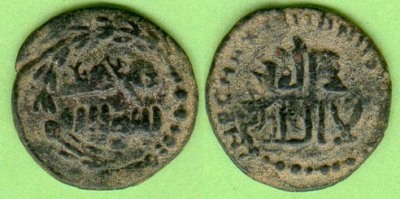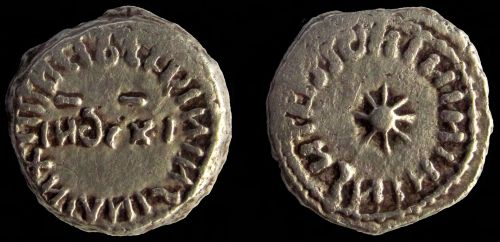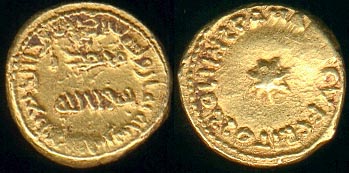I owe you all some blog posts! So I hope you don’t mind if they’re mostly about coins, because apparently at the beginning of 2017 I was dealing with coins at pretty much every level. The Roman stuff just discussed was being catalogued while I could still catalogue, but I’d chosen that stuff to catalogue because I needed to know what there was for teaching my late antique survey module. Teaching with coinage on my final-year special subject is harder, because for much of the period of Iberian history it covers there was no, or almost no, coinage being issued in the Latin kingdoms, and I don’t read the Arabic with which I might better understand the Muslim state’s or states’ stuff, and either way the Leeds collection has basically none of it. I did, however, run one class on the economy of al-Andalus, focusing on money and slaves, and for that I wanted to show the students some coins, even if the most they got from it would be that the state had considerable powers of standardisation, that the Islamic standard of coinage was fairly universal and that when the caliphate began it reintroduced gold coinage and that was no coincidence. Those all seemed like worthwhile teaching points…

Gold dinar of Caliph ‘Abd al-Raḥmān III al-Nasir struck in al-Andalus in AD 929-930, Tonegawa Collection 6871
So I went hunting for a resource to use and remembered the existence of something I had once found, the Tonegawa Collection. If you haven’t met it, this is an increasingly-comprehensive open online and expressly anti-copyright collection of images of and information on coins of al-Andalus; but right now, it was an English-language resource with many pictures and so I leapt at it. Of course, I had actually to look at it first to ensure that this would probably work, and in the course of that I learnt many cool things about Andalusī (i. e. Iberian Muslim) coinage and stubbed this post in which to tell you all of them.
Some of these things I knew already, like this one. The Visigothic kingdom that the Muslim forces took over in the Iberian Peninsula in 711 had had a mostly-gold coinage of so-called tremisses, technically one-third of a Roman/Byzantine solidus. Unlike most places where Islam took over a tax system, where it just maintained the existing coinage until the application of a new one had been worked out, here something more studied was done: the new régime struck solidi, which the Visigoths had not for a long time, on the Byzantine weight standard and with halves and thirds like the Byzantines, but of a new design with Latin inscriptions recording the value, country of issue (Hispania) and the Islamic date, and a star on the other side. There were also copper-alloy coins of a less standard kind.1 Conventional wisdom is that this was the application of the system the Muslims had met at Carthage when they took that, but that had been thirty years before, since which time coinage there had been regularised with that of the rest of the Islamic world, and in any case the last solidi from Islamic Carthage were fat globby things quite unlike these in both fabric or design.2
Next, five years later, came coins closer to Islamic dinar weights, with both Latin and Arabic inscriptions as you see above, and then five years after that regular Islamic dinars, then soon after that gold ceased to be issued and it was only silver dirhams and copper-alloy fulūs till the new Caliphate in 929 (see the first illustration). Whatever was going on here involved some deliberate decisions about how this was going to work and perhaps some early sense that this was going to be a new province of a different kind to the other Islamic possessions. There’s a story from the later Arabic sources that the first delegate governor of al-Andalus, ‘Abd al-Azīz, son of the governor of Ifrīqīyya who had conquered the peninsula, married the widow of the last Visigothic king and started looking as if he would set up as the new one, so that his men murdered him for his pretensions; I wonder if this coinage is showing us the same thing, a potential breakway régime which thought it was too far from Damascus to be stopped and in the end proved to be wrong.3
Likewise, it’s interesting to me that throughout the history of the rule of some kind of the first, Umayyad, ruling dynasty of Islam in the peninsula, the mint named on the precious-metal coinage was almost never more specific than the whole province, first Hispania then al-Andalus, as if any minting place was the same given the uniformity of control.4 Given how shaky Umayyad control often was here, that might have been quite an important thing to assert: coinage of Toledo or wherever would have been politically contentious when the city rebelled, as it often did, but while all the coinage was from ‘al-Andalus’, even when the governors or emirs controlled relatively little of that space, at least their money would not make that obvious. It’s frustrating not knowing where they were made, of course, but there was probably a point to it.

Copper-alloy coin of one Ibn Qāsī struck at an uncertain mint and date, Tonegawa Collection 10. The Arabic which identifies the issue apparently more or less renders as ‘Son of Cassius/Qāsī’ and ‘Conquest’, which is fascinating if so, but obviously isn’t all the script on the coin so if anyone feels like decoding the rest for me I would be in their debt and would footnote their assistance in subsequent publication…
Now this much I already knew, largely because of long ago having copy-edited the volume I’ve been citing for it all. But the Tonegawa Collection showed me lots of new things. For example, I dimly knew that Islamic law considers only precious-metal coinage to be the business of the state, so that base-metal small change can effectively be provided privately.5 It could, though, also be provided at intermediate level, such as by city or March governors, and that’s how come the above is a coin of the infamous Banū Qāsī, the frontier warlords about whom at this point I’d only a year before written the first English-language synthesis longer than a paragraph.6 Was that just necessity, at one of the periods when they held the big city of Zaragoza, to keep the markets and tax systems running, or was the chance to issue even base-metal coin part of how they tried to embed themselves into the area before anyone could come along and push them out of it again? I hadn’t realised that the coinage could be a source here, because no-one who works on them mentions it, but now when I finally revise that paper, I can.

Copper-alloy fals overstruck in al-Andalus at an uncertain date on a nummus of Emperor Maximian, Tonegawa Collection IIF
I could go on for a while, but I’ll keep it to just these two further things. This is a copper-alloy fals, and I can’t tell you anything really about who issued it or when—though if anyone reading can make anything of the legend I would love to know—but I can tell you that it didn’t start this way, as this has been struck straight onto a Roman nummus of Emperor Maximian (285-305, 307-308 and 310). Coins like this have been the seed of a long (friendly) argument between me and Eduardo Manzano Moreno, who has indeed now published his side of the dispute (on which more in a couple of posts). I maintain, backed by now considerable finds evidence, that there were Visigothic base-metal coinages struck in the Peninsula; he maintains that coins like these show that the circulating medium of small change was actually reused or still-used Roman coins.7 I thought that unlikely, but there are, as this demonstrates, coins that make him at least part right. They don’t make me wrong about the Visigothic stuff, though! Nonetheless, what this is is a coin that, even if not continuously, had been in use for at least 429 years when this happened to it, perhaps rather more, and which presumably then went to be used some more before someone helpfully lost it or hoarded it. You can see why I was sceptical, but as it’s true it is, as Neil would have said, pretty heavy, man.

Double-pierced silver dirham of ‘Abd al-Rahman III al-Nasir struck in al-Andalus in AD 930–31, Tonegawa Collection 3b
Lastly, as any of you who have worked closely with me and my numismatic buddies will know, we think piercing of coins is really interesting.8 Apart from anything else, it tells us that despite the presumably-fixed value of the coin in precious metal, it was still worth more for someone to bore some of that metal out of it and hang it on a string or whatever than to maintain that. You can sometimes tell a lot by how a coin is pierced; if it was hung on a string, for example, what face would be the right way up? Which way through was the hole pushed? Does that match? If there are two holes, it was probably going to be stitched to fabric; how does that change our picture? Here, we seem to have both: the damage at the edge seems to be where a single piercing caused the edge to crack off, and then someone put two holes through it more centrally. Or perhaps those things happened the other way round, who knows? So had this coin been crossing some kind of culture divide, was this change of use, or had it just fallen off whatever it was attached to and someone decided to make sure? We can’t answer these questions, of course, at least not normally, but their answers would make up individual object biographies in which the coin interacted with its different and equally individual users, and this coin apparently did more obvious interaction than many.9 I wonder what?
Anyway. That is enough numismatic effusion for now, especially given that the next post will contain more. Imagine how much worse it would be if I could read these things…
1. My guide here is of course Miquel Crusafont, Anna M. Balaguer and Philip Grierson, Medieval European Coinage, with a catalogue of the coins in the Fitzwilliam Museum, Cambridge, 6: The Iberian Peninsula (Cambridge 2013), pp. 54-61.
2. See Philip Grierson, Byzantine Coins (London 1982), pp. 147-148.
3. On the story and its background see Roger Collins, The Arab Conquest of Spain 710–797 (Oxford 1989), pp. 37-38.
4. Crusafont, Balaguer & Grierson, Medieval European Coinage 6, p. 59. The exception is the period 947-961, when the coins of ‘Abd al-Raḥmān III were issued from his palace at Madinat al-Zahra’, outside Córdoba.
5. See Stefan Heidemann, “Numismatics” in Chase F. Robinson (ed.), The New Cambridge History of Islam: Volume 1: The Formation of the Islamic World, Sixth to Eleventh Centuries (Cambridge 2010), pp. 648–663 at pp. 649-651.
6. Jonathan Jarrett, “Heartland and Frontier from the Perspective of the Banū Qasī, 842-907”, unpublished paper presented at the International Medieval Congress, University of Leeds, 9th July 2015; it does, alas, remain unpublished, but I can also offer you Jonathan Jarrett, “Before the Reconquista: frontier relations in medieval Iberia 718 to 1031” in Javier Muñoz-Basols, Laura Lonsdale and Manuel Delgado (edd.), The Routledge Companion to Iberian Studies (London 2017), pp. 27–40 at pp. 28-29, assuming of course that you cannot access the much more comprehensive Jesús Lorenzo Jiménez, La dawla de los Banū Qasī: origen, auge y caída de una dinastía muladí en la frontera superior de al-Andalus, Estudios Árabes e Islámicos: Monografias 17 (Madrid 2010).
7. Eduardo Manzano Moreno and Alberto Canto, “The Value of Wealth: Coins and Coinage in Iberian Early Medieval Documents” in †Simon Barton and Robert Portass (edd.), Beyond the Reconquista: New Directions in the History of Medieval Iberia (711-1085) In Honour of Simon Barton, The Medieval and Early Modern Iberian World 76 (Leiden 2020), pp. 169–197. In my defence I cite Ruth Pliego, “The Circulation of Copper Coins in the Iberian Peninsula during the Visigothic Period: new approaches” in Journal of Archaeological Numismatics Vol. 5/6 (Madrid 2015), pp. 125–160, for my copy of which I must thank the author.
8. On coin piercing see Rebecca Darley, “Money, Art and Representation: the powerful and pragmatic faces of medieval coinage” in Rory Naismith (ed.), A Cultural History of Money in the Medieval Age, Cultural History of Money 2 (London 2019), pp. 99–124 at pp. 119-121.
9. You probably don’t need a reference for the idea of object biographies but if you want one, here are two, Arjun Appadurai, “Introduction: commodities and the politics of value” in idem (ed.), The Social Life of Things: commodities in cultural perspective (Cambridge 1986), pp. 3-63, and Karin Dannehl, “Object Biographies: from production to consumption” in Karen Harvey (ed.), History and Material Culture: a student’s guide to approaching alternative sources (London 2009), pp. 123–138.





Fascinating again! I know the Tonegawa collection very well, and found out a lot more about its background from a Spanish curator when I was at a conference in Japan last year (I had assumed the name meant there was a Japanese connection, but apparently that is a red herring – it’s basically the work of a wealthy Spanish expat). Also, have you come across Tawfiq Ibrahim and his work on seals from al-Andalus (most of it on Academia.edu)? He has found all sorts of amazing things, mostly from the 8th and 9th centuries.
Señor Ibrahim is, indeed, the curator of the Tonegawa Collection, or so he has claimed to me, though that was a conversation full of possibly-tall stories, and while I don’t know his work as well as I should, I am trying to fix that. Mind you, I could say that of so many interesting numismatists, not least yourself…
Thaks for making such good use of the Tonegawa Collection which is of my five decades construction. Tonegawa is Japanese family name of my “widow-in-waiting”, that is if the Gods or watever so decide.
Take good care.
Tawfiq
Pingback: Name in Print XXVI: in honour of Simon Barton (and Mark Whittow) | A Corner of Tenth-Century Europe
Dear Jonathan. Your effort is certainly deserving of a rational plus.
The Visigothic fiduciary coppers certainly do exist no matter what our dear friend Eduardo Manzano and others in ivory towers might like to pontificate . I Spain nobody chages an original opinion no matter what evidence, it’s just not pat of our nationality character. I am being very unfair, the whole Mediterranean may be that way (joke, but rnearly trur). Any sun taned and weathered face metal detectorist barely literate knows that there are varied Visigothic coppers. Those ‘minimie’ appear in places with only Visgoth remains. An SP one appears very regularly in Aljarafe just down the Gualquivir a very little bit from Séville. All the ivory towerers pontificate with vehemence that those letters are jus the Byzantine for SPANIA, could very well be, why not, reasonable supposition. But very recently in a private collection I located and was able to picture a very strange bilingual led seal. One side in Arabic, “musalakha” and other side just what see to be S P with a stem in between. It confused me and just showed it Ruth Pliego and thanks to her insights we have an article in The last Al- QANTARA. I will not spoil its contents for you, just see in that magazine or in my academia.edu. Tell me what you think
By the way the TONEGAWA in the coin site name is the family name of my very patient Japanese Widow-in-waiting, so due to longevity of the said nationality the Japanese ownership is well guaranteed. That only the Oracle or God only knows.
Thankyou very much for commenting on this, Tawfiq. I did of course remember you telling me where the collection’s name had come from when we met in Leeds, but I wasn’t sure if it was ‘public’ information, so I didn’t use it here. The new find sounds intriguing and I will seek out the article and be in touch if I have any comments. I presume it’s this one. For now, I would just observe that SPania as a mint signature works well as a parallel to ‘al-Andalus’, but if the things keep turning up around Sevilla, then we can probably still assume that they were made there even if the signature is Spania not Hispalis…